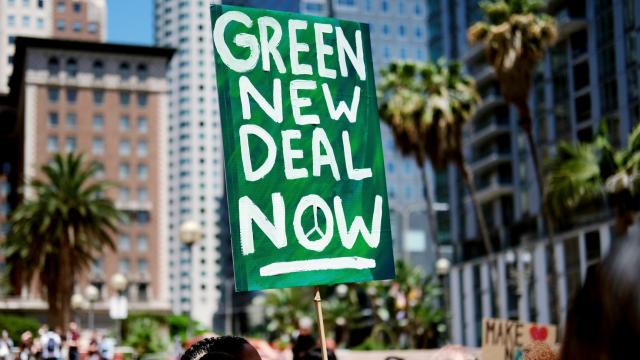The U.S. is screwing up its climate targets, but it’s far from the only country doing so. This year’s international climate talks, which included 200 nations, failed to deliver more ambitious goals to cut emissions and most countries are set to miss targets to meet the Paris Agreement goals to limit global heating.
But a new study shows it doesn’t have to be that way. The research, published in One Earth on Friday, lays out roadmaps for 143 countries to move to 100 per cent renewable energy by 2050 and create a near-global Green New Deal. The modelling represents what may be a best case scenario, but there’s a good argument we should be striving to create the best world possible.
“These plans are really the scientific basis… for Green New Deals,” Stanford University’s Mark Z. Jacobson, the study’s lead author, told Earther. “Some sectors might get there even faster, and some countries might get there even faster. But by 2050, it’ll be technically and economically possible to do this in 143 countries.”
Unlike some renewable energy plans which focus only on transitioning electric power, Jacobson’s Green New Deal roadmaps map out plans to transition all sectors of the global economy. That’s a central part of the Green New Deal for the U.S. proposed by Representative Alexandria Ocasio-Cortez. And Elizabeth Warren’s just-released Green New Deal also makes the case for decarbonizing everything because, well, we have to.
[referenced url=” thumb=” title=” excerpt=”]
Jacobson’s study zooms and looks at what that would look like for most of the world. It looks at the feasibility of developing enough wind, water, and solar energy infrastructure to supply 80 per cent of all power by 2030 and 100 per cent by 2050. And power in this case doesn’t just mean for when you flip the light switch. It means electrifying everything from transportation to agriculture to even the military, all while improving efficiency. According to Jacobson, we have 95 per cent of the technology we need, but that 5 per cent”including “long distance aircraft and long distance ships that we think will run on hydrogen fuel cells””aren’t yet commercialized.
“The idea is to eliminate all fossil fuel use and biofuel use, and we also don’t need nuclear,” said Jacobson. “We could rely on 100 per cent clean and renewable energy.”
Jacbonson’s work has come under fire in the past for being too aggressively optimistic, particularly the idea that the world can eschew nuclear power and still limit warming to within 1.5 degrees Celsius (2.7 degrees Fahrenheit) of pre-industrial levels. Staffan Qvist, an energy consultant who was part of a group of researchers who wrote a response to Jacobson’s work in 2017, said the global transition away from fossil fuels without nuclear was “certainly possible,” but raised questions about the cost effectiveness and potential adverse impacts on land use and materials”particularly rare Earth metals needed for batteries and renewables”as possible tradeoffs.
“There is a really stark discrepancy between modelled results of this kind and actual real-world results,” he told Earther in an email. “Germany is an ideal example, as it is a nation that for a long time has been completely committed to a transition to 100% renewable energy and which has decided to phase out all of its nuclear power plants. In the results of many academic “˜100% renewable’ studies, this type of transition should be smooth, cheap, quick and painless, and should starts to pay off very quickly. Reality looks different. Germany has, after spending many hundreds of billions of euros, failed completely, spectacularly, at even partially decarbonising. German power prices are rising rapidly and consumers are now paying the highest rates in all of Europe.”
These electrification red flags are obviously concerning, but there are also other benefits that the study shows would come with the transition. In typical Green New Deal fashion, the benefits of this transition could ripple well beyond the climate ones. Jacobson and his co-authors project that electrifying everything with clean, renewable, efficient energy would reduce power demand by 57 per cent, result in 28.6 million more jobs, and reduce energy bills, healthcare costs, and climate policy costs by 91 per cent. Modelling numbers in Warren’s plan as well as others presidential candidates have pointed to similar job-creating and cost-saving benefits.
That’s not to say there wouldn’t be up front costs. For the U.S. alone, the study estimates the transition would cost $US7.8 ($11) trillion on the front end. But the costs of climate inaction are much greater. And Jacobson found that if the U.S musters up the will to go go through with the difficult transition to 100 per cent renewables, the country could make up the costs of the transition within six years. And if you consider how much money would be saved in healthcare costs because of lowered pollution, lower crop losses from extreme weather, and less disasters to cleanup, that goes down to less than a year and a half.
But we’ve still got a long way to go, especially in terms of political will.
“It’s really helpful to know that we have numbers and know what the costs are…because you get all these naysayers saying it’s so expensive to do this and that and the other thing,” Jacobson said. “What this paper is trying to show, it’s not more expensive. Pretty soon, it’s much cheaper.
“I just hope that this gives people confidence that each country can do it.”
